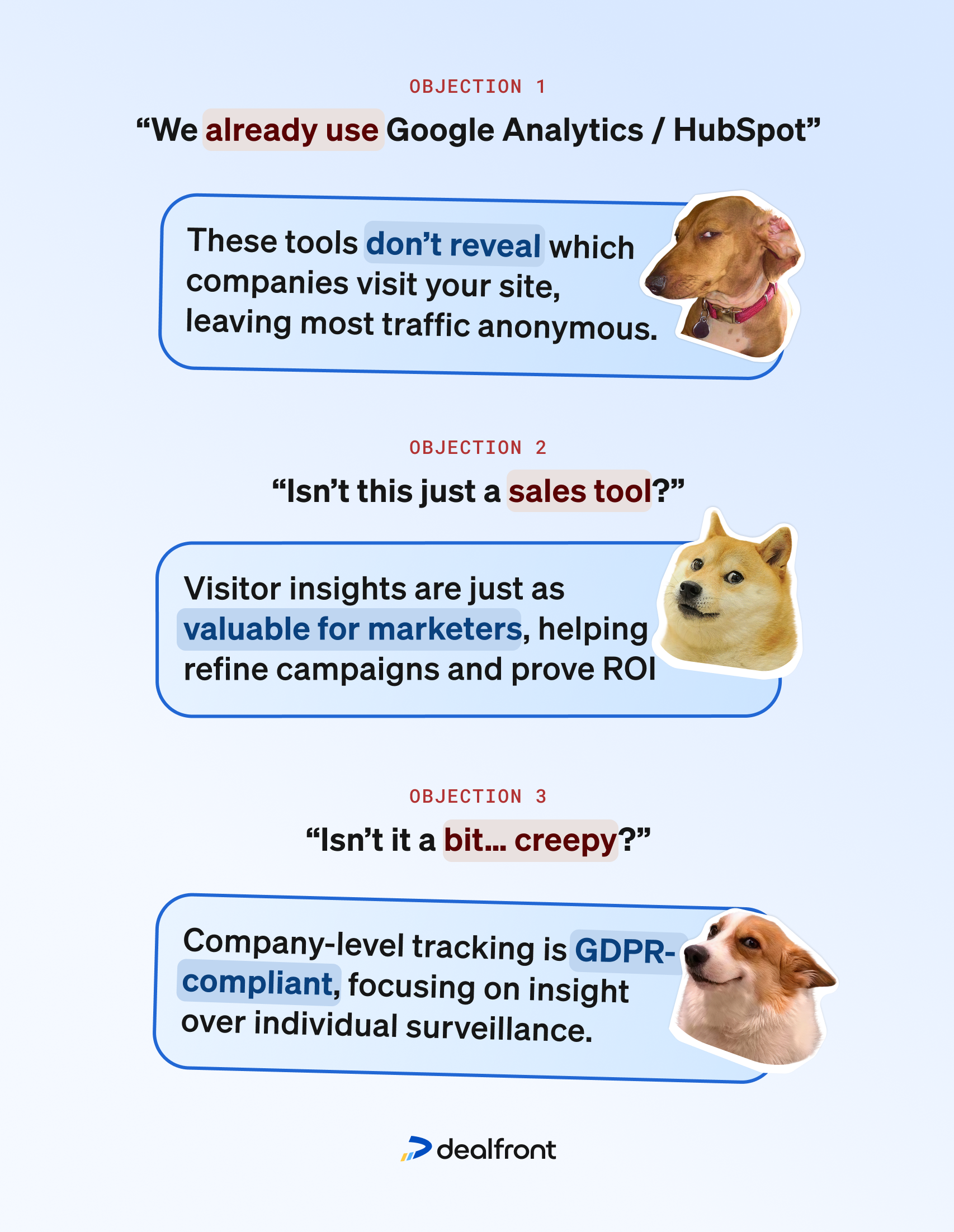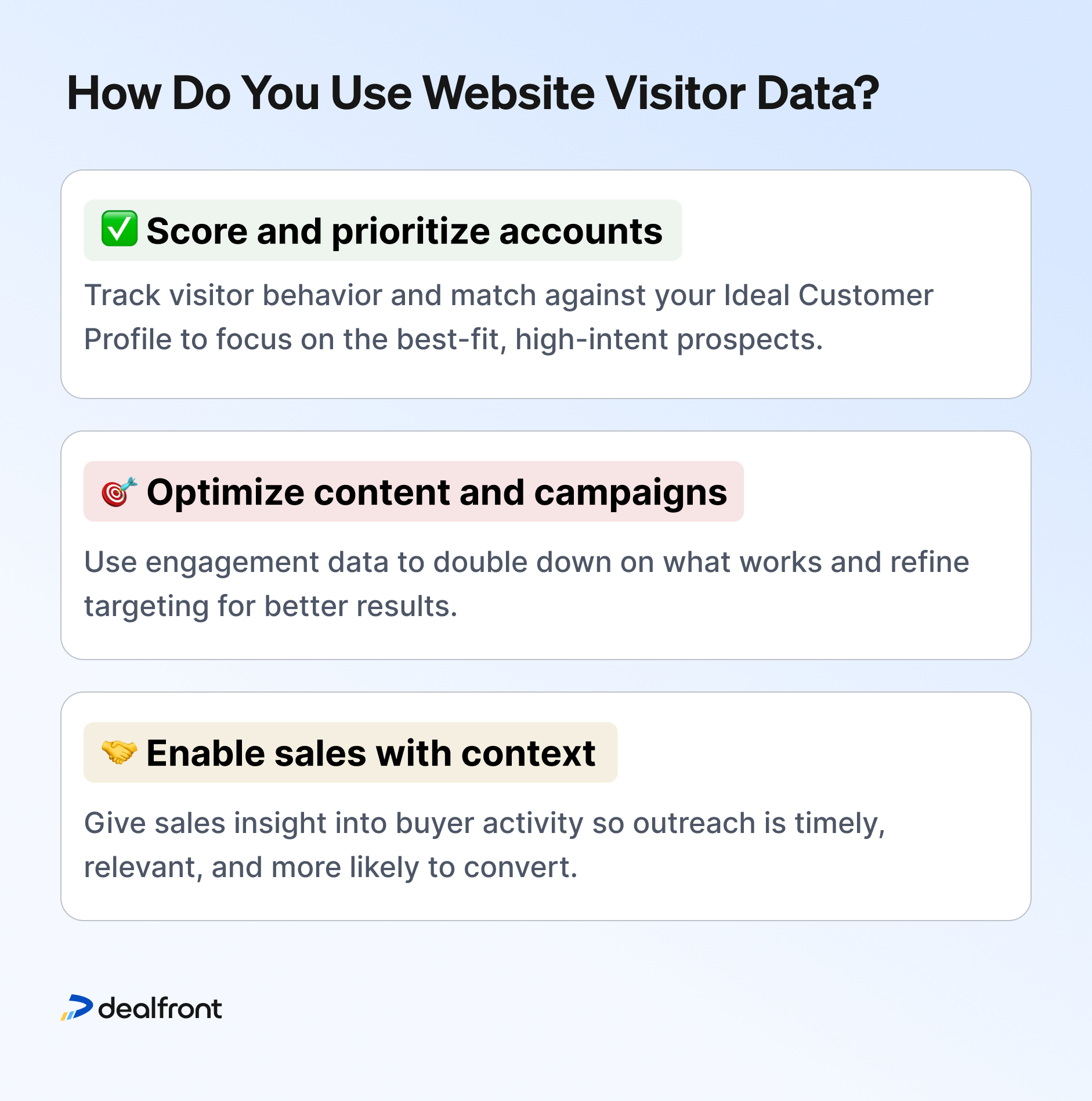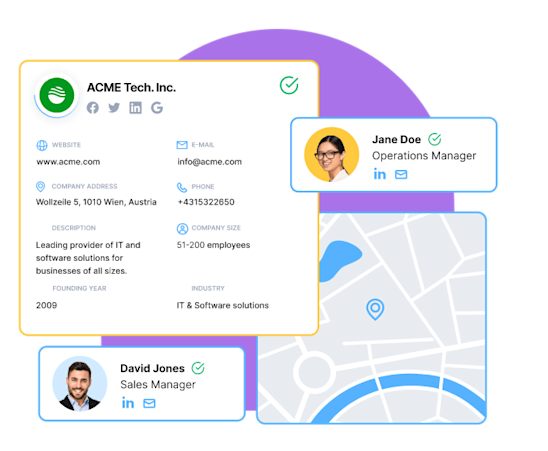60-Second Summary
The majority of valuable B2B website traffic never converts via form, leaving marketers blind to in-market interest. By leveraging website visitor intelligence tools like Dealfront, marketers can turn anonymous engagement into real pipeline opportunities.
Key insight: 97% of B2B visitors remain anonymous, meaning most potential buyers are invisible without tools like Dealfront—revealing who’s on your site is the first step to engaging smarter.
Standout tactic: Use website behavior—like repeat visits to high-intent pages—and match visitors against your ICP to prioritize outreach and trigger real-time, account-specific workflows.
Framework in action: Actito and SolFox used Dealfront to shift from guesswork to opportunity—converting up to 75% of their sales from visitor intelligence-led outreach.
Revenue alignment: Real-time visitor data bridges the gap between marketing and sales—enabling shared visibility, warmer outreach, and faster deal cycles.
Sadly, this isn’t a hypothetical scenario. In fact, an estimated 97% of B2B website visitors never fill out a form or take any trackable action. They browse, compare, maybe even linger on your pricing page… and then vanish into the ether like a party guest making a french exit.
And yet, those anonymous visits could be the warmest leads you’ve had all week.
In the age of intent-based marketing, B2B marketers can’t afford to keep flying blind. If you don’t know which companies are visiting your website, you’re leaving revenue, and insight, on the table.
But you don’t need a crystal ball to resolve your ghosting issues. Tools like Dealfront are helping marketing teams identify which companies are showing interest, how they’re behaving, and what to do next, without relying on form-fills, guesswork, or overly enthusiastic SDRs.
In this article, we’ll explore why website visitor data matters more than ever, what you’re missing without it, and how to turn invisible interest into pipeline.
What You’re Missing Without Website Visitor Data
It’s a familiar scene in many B2B marketing teams: leads are drying up, sales want more “ready-to-buy” accounts, and everyone’s staring at a dashboard full of clicks, impressions, and form-fills with no clear idea of what’s actually working.
We’re told to track engagement. So we measure CTRs, cost-per-lead, bounce rates, and content downloads. But these numbers rarely tell you who is engaging, or whether they’re even part of your ideal customer profile. As a result, high-value web traffic slips through unnoticed. Maybe someone from your target account spends 15 minutes on your product page, checks your pricing, and downloads a whitepaper, but never fills out a form. What happens next? Usually... nothing. Most companies are still operating in the dark and would never know they’d had an in-market buyer sat right there on the website.
This is the marketing data gap. The one between anonymous engagement and actual opportunity. In today’s account-based, intent-led B2B landscape, it’s a gap that can quietly drain pipeline and budget.
“For too long, B2B marketing has been caught in the trap of vanity metrics and channel silos,” says the team at Dealfront. “We’ve been measuring clicks and form fills when what truly matters is pipeline, revenue, and proving real company engagement.”
When marketers rely only on Google Analytics, form submissions, or campaign-level metrics, they lose sight of the bigger picture: which companies are interested, and what they're actually doing. The problem here is, if you can’t see your buyers, how can you move them forward?
The Value of Knowing Who’s Visiting
When you know who’s visiting your website, even if they don’t fill out a form, everything changes. Suddenly, you’re not guessing. You’re not relying on proxy metrics or wondering if your content is attracting the right people. You have visibility and you have direction. You can see which companies are engaging, what they’re interested in, and how close they might be to a buying decision. This is what visitor intelligence offers, and it’s a game-changer for B2B marketers.
Website visitor identification powers sharper segmentation, so instead of targeting huge swathes of people based on job titles or industries, you can zero in on companies already showing intent, then tailor your campaigns accordingly. That’s good news for ROI (and your ad budget). It also means you can unlock personalised outreach. If you know a company has browsed your pricing page three times in the past week, you can create a message that meets them exactly where they are in their journey, instead of sending a generic nurture email about your latest blog post.
Another benefit of being able to see who’s visiting your site is that you can prioritise the accounts that you’re most interested in. With visitor data, both sales and marketing can focus on companies actively researching your solution, not just the ones on a static ABM list from six months ago. But perhaps most importantly, this also means that, finally, marketing and sales are brought onto the same page. When both teams have access to real-time insight on which accounts are warming up, it becomes easier to align efforts, share context, and move deals forward faster.
“At Dealfront, we fundamentally believe marketers must move beyond volume and own their impact on the bottom line,” Sam O’Brien, VP of Marketing at Dealfront explains. “That’s why this approach is so critical; it gives us the clarity to finally connect paid media to tangible business growth.”
With tools like Dealfront, marketing teams can instantly see which businesses are actively researching their solutions, and give sales teams the context and confidence to strike up the right conversation, at the right time.
Common Objections And Why They Don’t Hold Up
Even with all the upside, some B2B marketers still hesitate to invest in website visitor intelligence. That’s understandable as the martech stack is crowded, budgets are tight, and it’s easy to think “we’re already covered”.
So, let’s unpack a few of the most common objections and explore why they don’t really hold up under scrutiny:

“We already use Google Analytics / HubSpot.”
Sure, lots of teams really are, and that’s great. But these tools weren’t designed to show you which companies are visiting your site. Google Analytics gives you general traffic trends (device, location, time-on-page), and HubSpot captures known contacts, after they’ve converted.
The problem is, most B2B website traffic never converts.
In fact, HubSpot reports that the average website conversion rate across B2B industries is just 2.4%. That means 97.6% of your visitors, potentially valuable prospects, remain anonymous. And that’s a huge blind spot.
Tools like Dealfront fill that gap, revealing the company names behind anonymous visits and mapping them to key intent signals, so you can act before the trail goes cold.
“Isn’t this just a sales tool?”
Nope, not anymore - and if you still think it is, you need to pull your head out of 2020. Sales teams certainly benefit from visitor insights, but for marketers, this data is just as powerful - if not more so.
Knowing who’s engaging (and what they’re engaging with) helps marketers refine messaging, tailor campaigns, test content effectiveness, and prove ROI to stakeholders. It’s not just focusing on hand-raisers, it’s real value lies in enabling marketers to spot the silent signals of buying intent, and shape their strategies accordingly.
“Isn’t it a bit… creepy?”
Fair question, and if you’re playing at the level of individual, person-level identification, you might have a point (or a lawsuit on your hands). However, company-level website identification isn’t about tracking individuals, and certainly isn’t spying. The key to getting this right (and therefore safe and not creepy) is maintaining a highly ethical and compliant standard of data collection.
Tools like Dealfront use GDPR-compliant methods such as reverse IP lookup and proprietary data matching to identify which companies are visiting; not who specifically clicked what. This method focuses on insight, not intrusion, and it keeps trust and transparency intact.
How Do You Use Website Visitor Data?
Getting visibility into which companies are visiting your site is one thing. Knowing how to use that insight? That’s where the real value lies.
Visitor intelligence isn’t just another line in a report — it’s fuel for smarter, faster, more effective marketing. Here’s how to turn raw data into real impact.

1. Score and prioritize accounts
Not every visitor is worth their weight in gold… but some are! By tracking behaviors like time on site, pages viewed, or visits to high-intent areas (like pricing or product features), you can build an intent scoring model that surfaces your hottest prospects automatically.
This helps marketing stay focused and helps sales know who to engage, and when. With Dealfront’s new ICP Insights feature, you can go one step further, by automatically matching site visitors against your Ideal Customer Profile. This means your teams aren't just prioritizing based on behavior, but also on fit. It’s a powerful way to focus effort where it counts and make sure your best opportunities never slip through the net.
2. Trigger smart workflows
When a key account shows signs of intent, don’t let it just sit in a spreadsheet. Tools like Dealfront integrate directly with your CRM and marketing platforms, so you can automatically trigger alerts, assign leads, or drop accounts into relevant nurture sequences, all based on real-time behavior.
This means no more manual follow-ups, and no more guesswork, saving you time and boosting your efficiency.
3. Optimise your content and campaigns
Seeing how target companies engage with your content reveals what’s resonating, and what’s not. That means you can double down on the formats and topics that actually move buyers forward, and refine your ad targeting to reach similar profiles.
According to McKinsey, companies that use customer behavioral insights in their strategy, outperform their peers by 85% in sales growth and over 25% in gross margin. That’s how powerful relevance is when incorporated into your campaigns. It all starts with knowing who’s on your site, and what they care about.
4. Enable sales with context
When sales teams know which companies are warming up, what they’ve read, and how often they’ve come back, they can reach out with tailored messaging that feels timely, not pushy.
Ultimately, that creates a nicer experience for the buyer, while also shortening the sales cycle and improving your win rate.
Visitor intelligence is only as powerful as what you do with it. That’s why having the right tech stack can make it easy to integrate insights directly into your tools and workflows, meaning you can act in the moment, not weeks later when it’s already too late.
How B2B Marketers Are Turning Website Visitors into Revenue
It’s one thing to talk about the potential of website visitor data, but quite another to see what happens when businesses actually put it to work.
In reality, most B2B marketing teams already have high-intent traffic coming to their site every single day. But without the right tools, those visits remain nothing more than numbers in Google Analytics: untraceable, unactionable, and ultimately, unconverted. Fortunately, that changes when you start identifying who’s behind the visit.
Below are two real examples of how Dealfront customers transformed their marketing and sales performance by closing the gap between web engagement and revenue. From better-qualified leads to full sales alignment and more efficient workflows, here’s what happens when anonymous traffic becomes a real opportunity:
Actito turned intent into 75% of their sales
Actito, a Belgian marketing-automation platform, had an established ABM strategy but lacked clarity on which companies were genuinely researching their services. Most website visitors remained anonymous, and engagement insights were limited.
By integrating Leadfeeder (powered by Dealfront) into their SDR workflows, Actito’s team began tracking and scoring website visitors, filtering by ICP, pages viewed, and recurring visits. They used custom feeds, CRM integrations, and team alerts to prioritize outreach and tailor messaging. As a result:
61% of identified ICP accounts converted into opportunities
75% of all new sales were attributable to Leadfeeder‑driven pipeline
Their SDRs could see intent, trace behavior, and engage at the right time, turning previously invisible traffic into qualified leads and pipeline.
SolFox gets 50% of their new leads from website insights
SolFox, a lean Finnish engineering firm, knew they had solid traffic, but they had no idea who was visiting or why. Their marketing lacked clarity, and their sales team was reactive.
With Dealfront integrated into their daily workflow, SolFox now receives automated morning reports with high-intent company prospects. But what does that actually mean for them? Now, they get:
Approximately 50% of all new leads now originate from Dealfront data
Over half of Dealfront-identified leads convert, especially when contacted the day after the visit
As Partner Tommi Suomela shared:
Why these stories matter
What unites Actito and SolFox, two very different businesses, is a shared realisation: their most valuable website visitors weren’t filling in forms. And without the right tools, they were flying completely under the radar.
Actito used Dealfront to get marketing and sales on the same page, surfacing anonymous traffic and linking it to campaign performance. Instead of guessing what worked, they now know, and can prove ROI across the funnel.
SolFox, a leaner operation, uses Dealfront as a daily sales intelligence tool. Their team receives automatic alerts on high-intent companies and turns around outreach the very next day. Half of their new leads now originate from Dealfront.
Together, these stories show what’s possible when you:
Uncover the who behind the web visits
Align teams with the same insights
And act fast while buyer intent is fresh
Website traffic shouldn’t be a black box. With visitor intelligence, it becomes your most valuable source of leads, and one of the smartest investments in your marketing strategy.
Remember, Don’t Market Blind
In B2B marketing, not knowing is no longer an excuse. Your website is probably already attracting the right people: decision-makers, researchers, buyers. But if you’re only measuring form fills or surface-level metrics, you’re missing the bigger picture, and the bigger opportunities.
Visitor data bridges the gap between curiosity and conversion. It reveals which companies are actively exploring your offering, what they’re interested in, and when they’re ready to talk. And that’s insight your campaigns, content, and pipeline planning simply can’t afford to go without.
Platforms like Dealfront turn website traffic into insight, and insight into pipeline. You don’t need to work harder to get conversions, you just need to work with better visibility and the insights that website visitor data offers.
FAQs About Website Visitor Data
What is website visitor data in B2B marketing?
What is website visitor data in B2B marketing?
Website visitor data refers to information about the companies (not individuals) who visit your website, including firmographic details like company name, size, industry, and sometimes intent signals like pages viewed or visit frequency.
How is website visitor data collected without using forms?
How is website visitor data collected without using forms?
Tools like Dealfront use reverse IP lookup, cookies, and integrations with company databases to identify businesses visiting your site. This process is GDPR-compliant and focuses on company-level insights rather than personal data.
Doesn’t Google Analytics already tell me who’s visiting my website?
Doesn’t Google Analytics already tell me who’s visiting my website?
Not quite. Google Analytics shows what users are doing, but not who they are. It tracks sessions, bounce rates, and page views, but it doesn’t reveal the actual companies behind the traffic. Visitor intelligence fills that gap.
Why is visitor identification important for marketers?
Why is visitor identification important for marketers?
It helps marketers see which companies are engaging with content or campaigns, even if they don’t convert right away. This allows for better lead nurturing, campaign optimisation, and closer sales-marketing alignment.
Is this kind of tracking legal and GDPR-compliant?
Is this kind of tracking legal and GDPR-compliant?
Yes, when done properly. Platforms like Dealfront only track company-level data and adhere strictly to privacy regulations. They don’t reveal individuals or personal information, focusing instead on anonymised firmographic data.
Can sales teams use this data effectively too?
Can sales teams use this data effectively too?
Absolutely, sales teams can prioritise outreach based on real-time buying signals. If a company visits high-intent pages (like pricing or case studies), that can trigger a personalised, timely follow-up, often leading to warmer conversations and shorter sales cycles.
How does website visitor data integrate with my existing tools?
How does website visitor data integrate with my existing tools?
Most visitor intelligence platforms, including Dealfront, integrate with CRMs, marketing automation platforms, and sales tools. This allows you to trigger workflows, score leads, and enrich account data seamlessly.


